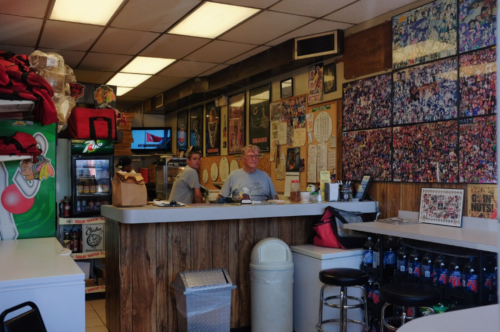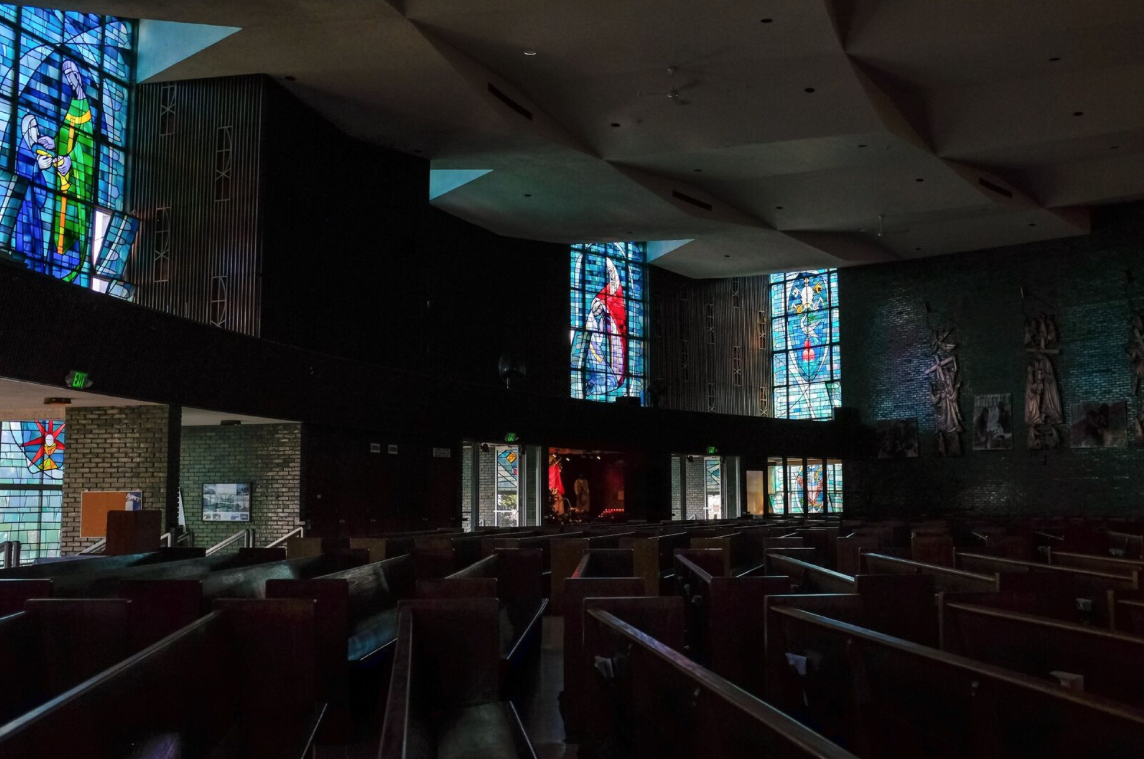- • Best Architecturally Unorthodox Church
- • Best Not-What-You’re-Thinking Pizza
- • Best Just-Outside-the-Airport Food
- • Best “Representatives”
I’ve lived in Gage Park for twenty-three years. Someone in my family had a house here—I believe it was my mother’s uncle who moved here, and then a few years later some cousins moved here, not to the same house, but to the same block, and then eventually when my parents immigrated from Mexico they ended up in the same neighborhood. I would even say that not just family members, but family friends that we know from Mexico will move into the neighborhood, basically on recommendation.
It’s very, very green here, and it’s really, really fertile. There’s a pretty big park that starts off on 54th and goes to 56th, from Claremont to about Maplewood, and I would say that park was really significant growing up. It’s where I was really introduced to things that I don’t think a lot of people are introduced to. As a Mexican immigrant, you usually just play soccer, but because of that park, from a young age I played hockey, baseball, I don’t know what else.
And the influence from the Czech community who used to live here is still very much felt. I couldn’t say a word in Czech now, but the church that I grew up going to, Saint Simon on 52nd and California, had services three times on Sunday, had one in English, one in Spanish, and one in Czech. Even though it’s very, very much—almost ninety percent—Mexican, there was a certain level of diversity, or I wouldn’t even say diversity, it was just sort of a taste, or influences, of other cultures, growing up in the neighborhood.
There’s only one bookstore around here, and it’s a Christian bookstore, though they do have books that aren’t Christian books, and there isn’t really a coffee shop. Do I wish there were nicer things around here? Sure, but it was fine growing up here—I’ve never known any other place, but I don’t know that it would have been any different, or better, in another neighborhood. It’s not much like Pilsen or Little Village in a sense that it’s become a destination for tourists; a lot of people who live here have moved southwest from those neighborhoods.
But unless it was work-related, I would always see myself living on the South Side. It’s a very friendly community. If you don’t say hi to strangers walking down the street, word will get around that you’re not friendly—I think it’s about as tight-knit as as a neighborhood could be in an urban area.
Rigo Dias is a Gage Park resident.
Best Architecturally Unorthodox Church
St. Gall Catholic Church
The corner of 55th and Kedzie Avenue is home to an unconventional building belonging to the Church of St. Gall, which has ministered to the Gage Park community for over a hundred years. The church’s present building, part of a larger campus that stretches down the block, forms a quarter-circle inscribed on the right angle of the street, perfectly interrupting Chicago’s inescapable grid. The dark gray stone and glass of the exterior facade, set well back from the street, are countered by a glass entryway that extends to the tip of the corner, topped by a rust-orange arch. On Sundays and during events, the doors that run along the facade are all opened, so that you can enter the church from every side and still find yourself staring straight at the altar. A long history on St. Gall’s website says only that the unique church building was designed to increase seating capacity and shorten the distance between the entry and the altar. (Jake Bittle)
St. Gall Catholic Church, 55th and Kedzie. English mass Sundays at 9am, Spanish mass Sundays at 7:30am, 10am, 12:30pm, and 6pm. (773) 737-3113. stgall.org
Best Not-What-You’re-Thinking Pizza
Pizza Castle

The counter clerks and cooks at this family-owned pizza joint on 55th often have to turn away tourists who stop by on their way from Midway in search of famed Chicago deep-dish. “That’s not what we do on the Southwest Side,” they scoff. To the owners, their cheesy, high-tomato thin-crust slices represent Chicago pizza done right, and they have the history to prove it—they’ve been serving up the same slices since 1973, a year before the first Giordano’s location was founded a mile south. Now, after a recent string of features on local news and national food television, business is better than ever: neighborhood kids stop by during the afternoon for a slice while delivery boys run in every few minutes and dash back out carrying boxes. The classic cheese and sausage pizzas are the best of the lot, but be sure to get a drink of water. (Jake Bittle)
Pizza Castle, 3256 W. 55th St. Monday 4pm–11pm, Tuesday–Thursday 4pm–11:30pm, Friday and Saturday 4pm–midnight; Sunday 3:30pm–10:30pm (last orders a half-hour before). (773) 776–1075.
Best Just-Outside-the-Airport Food
Sammy’s Kitchen
Just feet north of Midway International Airport—right across the street from the runways, in fact—is an unassuming, one-story building containing Sammy’s Kitchen: a shades-drawn, one-dollar-sign diner serving perfectly greasy food that makes what you can get in the nearby airport terminal seem even more disappointing than it already is. I stopped into the restaurant, on the corner of 55th and Luna, for an omelet and famous ham-on-the-bone one August afternoon and left feeling as though I had interacted with some ideal of American diner food. Despite its location, unique but not entirely favorable to those outside the neighborhood, a visit to this far-flung piece of perfection is well worth a trip on the crosstown bus. (Sam Stecklow)
Sammy’s Kitchen, 5542 W. 55th St. Monday–Friday, 6am–1pm; Saturday, 7am–noon. (773) 735-2802.
Best “Representatives”
Ed Burke & Michael Madigan
For nearly half a century, two of the most powerful men in the city have represented the Southwest Side. They haven’t always represented the same parts of it—the boundaries of their representation have shifted over the years, though not nearly as much as others’ have—but as the demographics of neighborhoods like Gage Park, Archer Heights, and Garfield Ridge have rapidly changed over the last three decades from mostly Irish and Eastern Europeans to largely first- and second-generation Mexican immigrants, their representatives have stayed the same: Michael Madigan, speaker of the Illinois House of Representatives, and Ed Burke, 14th Ward Alderman and head of Chicago City Council’s Finance Committee.
They are the last clinging, crusty barnacles of Richard J. Daley’s Democratic Machine—his protégés and friends, both of them—and they keep finding creative ways to remind us of that. The Daley inheritance is evident in the tricks they play with electoral maps to ensure their continued tenure (Madigan has long been responsible for statewide redistricting, and one of his earliest efforts notoriously created an invisible electoral wall separating the eastern black and western white South Side; as recently as 2011, City Council—the most powerful member of which is Ed Burke—faced criticisms from 23rd Ward Ald. Michael Zalewski that his ward had been “ripped apart” and that Burke and Madigan’s neighboring wards had benefited from it) and the extremely successful law firms they are partners in, both of which represent wealthy property owners in front of governmental bodies like the Cook County Assessor’s Office (which is headed by Madigan protégé and part-time Springfield lobbyist Joseph Berrios).
Notably, Burke came under fire this year when it was revealed he helped Donald Trump save nearly $12 million in property taxes for Trump Tower (at the expense of all other property taxpayers in Cook County, naturally) though this has somehow seemingly not hurt him in his ward, which is over seventy percent Latino.
The first elections Burke and Madigan won were not elections that the public could vote in. At twenty-four, Burke narrowly won an election voted on by the sixty-five 14th Ward precinct captains to replace his father as ward committeeman after his sudden death. A year later, in the neighboring 13th Ward, Madigan won another internal ward committeeman vote. Both still hold the positions and have disciplined ward organizations that ensure high Democratic voter turnout. Perhaps not coincidentally, they have almost never been seriously challenged for their seats: from 1971 to 2007 Burke ran unopposed. When he was challenged by a teacher and novice politician, one of his deputies filed a failed legal opposition to her campaign (Burke won ninety percent of the vote anyway). Madigan has been accused of responding to candidates for his 22nd District seat, many of whom are Latino and run on a platform of, you know, representing their community, by planting ghost candidates with Latino surnames to split the opposition vote. (Jason Gonzales, his first serious primary opponent in years, shared the ballot this past spring with two other candidates with Latino surnames, neither of whom raised money or campaigned actively).
Though Madigan and Burke are reviled state and citywide, respectively, their responsive services for their constituents also ensure their continued reelection, according to University of Illinois at Chicago political science professor and former alderman Dick Simpson, who regularly publishes reports on political corruption. Their positions of power, both in electoral bodies and Democratic Party organizations, give them considerable clout with which to provide favors, hand out jobs, and get ward and district problems fixed quickly. (Burke has even learned rudimentary Spanish, according to Simpson). Even a perennial Republican Madigan challenger, Terrence Goggin (who has faced accusations of being a ghost candidate himself), admitted to the Wall Street Journal that “Mike Madigan has done a lot of good things for the people in this area.”
That doesn’t mean, however, that if thumbs were lifted from the scales Madigan and Burke would be able to maintain their statuses as the longest-serving members of their respective electoral bodies. If an independent redistricting proposal, like Independent Maps (recently shot down by a legal challenge headed by Madigan’s top legal deputy and the Illinois Supreme Court, which Burke’s wife serves on) does ever get passed in the state, it could change Madigan’s district drastically, and his negative image throughout the state could result in his unseating, according to Simpson. Burke’s responsiveness to demographic shifts in his ward says to Simpson that he is able to change behavior to maintain power—but should independent redistricting come to Chicago and include a significant number of black voters in the 14th Ward, it could lead to Burke’s ouster. After the contentious Council Wars of the 1980s, in which white aldermen lead by Burke and Ed Vrdolyak revolted against the leadership of Harold Washington, Burke has had an overwhelmingly negative image in Chicago’s black communities, according to Simpson, which has also contributed to his inability to win a city or countywide office, something he has long coveted.
Barring an act of God or two, then, it seems the 14th Ward and 22nd District are stuck with Madigan and Burke for the foreseeable future, to their local benefit but to the seeming detriment of the rest of the city and state. The two quiet, private, fabulously wealthy titans of Chicago clout have shown no signs of weakness in recent years. Madigan has willingly stepped into a highly publicized budget stalemate with Governor Bruce Rauner and Burke has sponsored two pieces of pro-cop “Blue Lives Matter” legislation in City Council that have led to outsiders protesting by his ward office. In other cities or other states, actions like these would likely have ended their twin reigns, but that seems unlikely here—and, as long as both are in control of their electoral maps, downright impossible. As Madigan coyly told the Reader in a 1982 cover story about his racial gerrymandering of Chicago’s state legislative districts, “I know you can do a lot of interesting things when you’re drawing lines.” (Sam Stecklow)
Office of Alderman Edward W. Burke, 2650 W. 51st St. (773) 471-1414. ward14@cityofchicago.org
Office of Representative Michael J. Madigan, 6500 S. Pulaski Rd. (773) 581-8000.

